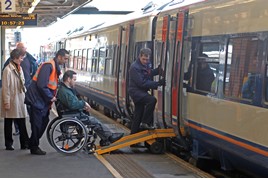“From the onboard perspective, deployable steps and ramps are available and we use these as required. In general, though, these systems are expensive, heavy and challenging to integrate - especially for existing train designs where the carbody structure would need to be significantly modified. The addition of new mechanical systems can also have an adverse impact on the overall reliability and availability of the train.”
Siemens’ current EMU for Britain is its Desiro as recently introduced on Thameslink as Class 700 and Moorgate services as Class 717. It has a floor height of 1,100mm which contrasts with the various heights offered on other Desiro EMUs in the rest of Europe. In Austria, OBB’s Desiro fleet has floors 600mm above rail level and the trains have sliding steps and a lift to cope with lower platforms. With these lower floors, much of the equipment that would be under them in a British train is placed on the roof instead.
Abellio’s Rhein-Ruhr Express has recently introduced another Desiro variant from Siemens. It too has lower floors, 800mm in the end cars and 730mm in the double-deck centre cars of these four-car electric units.
This suggests that it’s clearly possible to provide trains in Britain that have floors to match Network Rail’s standard platform height. It might not be as easy as in Continental Europe with its more generous loading gauge providing space above passengers for equipment. But it’s not impossible.
Recent franchise competitions have placed great emphasis on providing as many seats on a train as possible. This actively works against easy provision for wheelchair users. They need space to manoeuvre their chairs, universal access toilets take more space and, if floor heights are to vary, then the gentle gradients necessary for wheelchairs take more space than steps.
This contrasts with the priority for some inner suburban trains where space to stand takes over. With seats arranged longitudinally down the carriage sides in a style more usually associated with Tube trains, there is greater freedom for passengers in wheelchairs. If only they could board and alight without assistance.
What’s missing from much of Britain’s railway is any drive towards improving wheelchair access. Rather than insisting that Network Rail’s 915mm platform is the standard and that trains should match it (as Merseytravel has done), Britain’s funders and service specifiers have opted for indifference followed by frantic compromise.
Hence Crossrail and HS2 deciding on different platform heights (despite both planning to call at NR stations), the plethora of different ramps that staff are expected to manhandle into position, and the apps and helplines that let wheelchair users book help.
These mitigations would not be needed if Britain enforced a standard platform height and standard floor height. This would need careful planning as Merseyrail has shown. And it wouldn’t solve the access problem at every station because the geometry of the gap between platform and train becomes very complicated at curved platforms with tracks canted to allow trains to pass at speed.
Merseytravel shows what can be done when a funder becomes interested in solving a problem. Greater Anglia shows that it’s possible to improve access even without such direction. Had Britain not ordered so many thousands of new rail vehicles with high floors, it could now be embarking on a radical journey to open rail travel to many more passengers in wheelchairs. As Tanni Grey-Thompson told RailReview: “I just want to get on and off.” Not too much to ask, is it?
- During RailReview’s interview Baroness Tanni Grey-Thompson said she was very happy to hear from rail companies and others about travel for passengers in wheelchairs, using her Parliamentary email address which is [email protected]














